The ASUS ZenPad S (Z580CA) Review
by Brandon Chester on August 31, 2015 8:00 AM ESTGPU Performance
Rather than using Intel’s HD series iGPUs, the Atom Z3530 and Z3580 SoCs in both versions of the ZenPad S use Imagination Technologies’ PowerVR G6430 GPU. Since this implementation is identical to the one in the ZenFone 2 it’s not likely we’ll see a large gap in absolute performance. However, the larger chassis of the ZenPad may allow it to dissipate heat more effectively, which could help performance in long-term sustained workloads. It’s also worth noting that the less expensive Atom Z3530 model of the ZenPad S will suffer from reduced performance in GPU heavy workloads due to the 1GHz reduction in max CPU clock compared to the $299 model, as well as the drop in GPU speed from 533MHz to 457MHz.
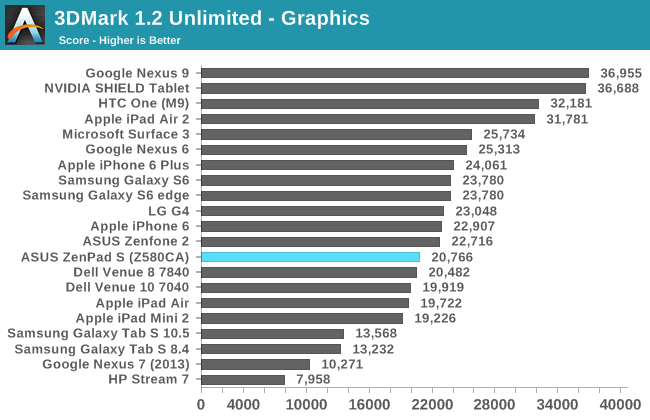
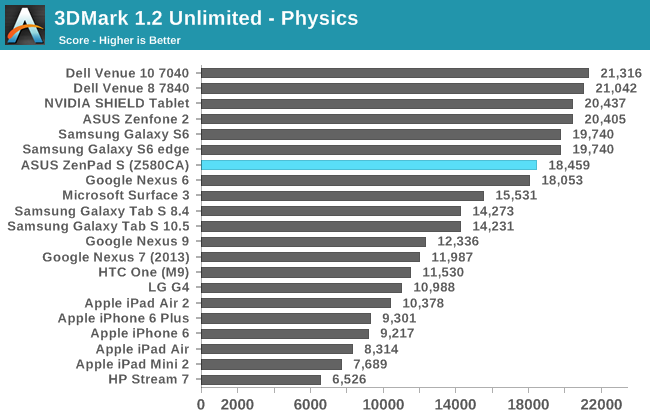
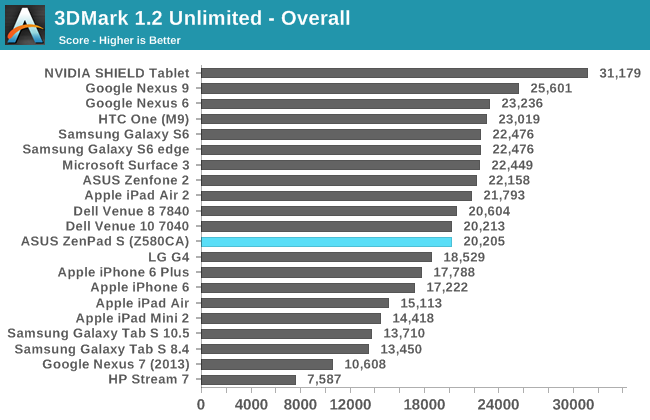
In 3DMark we actually see a noticeable gap between the ZenPad S and the ZenFone 2. The latter ends up scoring around 2000 points higher in both sub-tests, which leads to an overall score which is also around 2000 points higher. I would mostly attribute this to software differences rather than any issues with throttling, and the next tests will help to confirm that assumption.
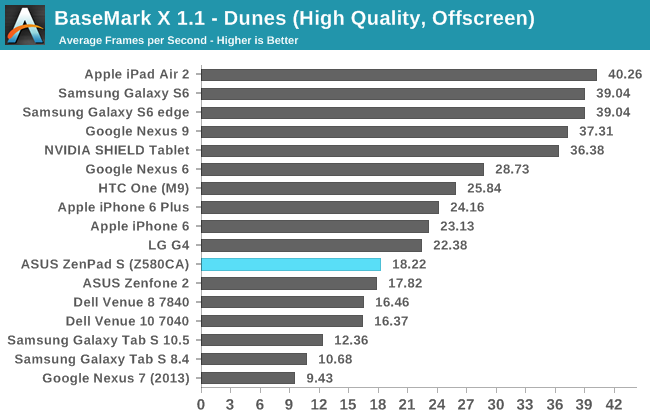
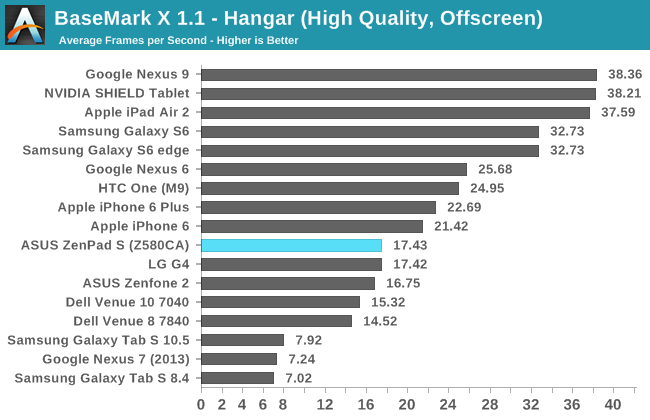

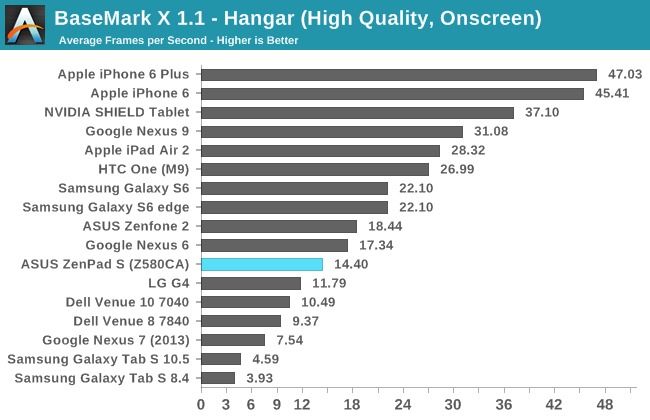
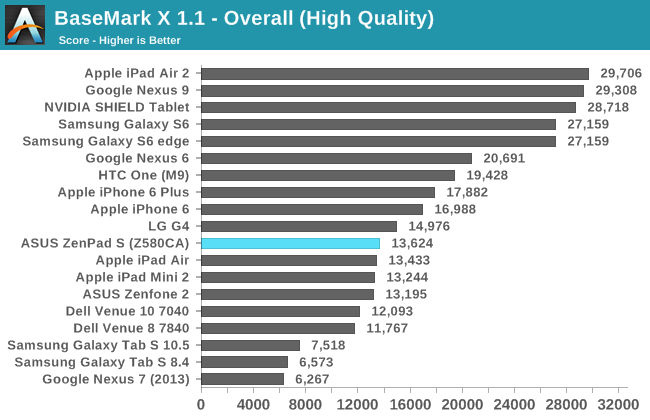
The ZenPad S doesn’t perform as well as the ZenFone 2 in BaseMark X’s on screen tests, which isn’t surprising given that it’s pushing 1.6 million more pixels. In the off screen tests we see both devices perform roughly equally, and this is reflected in the overall score. In other reviews, such as my review of the Dell Venue 8 and Venue 10 I mentioned that G6430 is a bit slow compared to the competition at that price point. For a $299 it fits perfectly, and coincidentally a lower clocked version of it is what’s used in the iPad Mini 2 which is also $299.
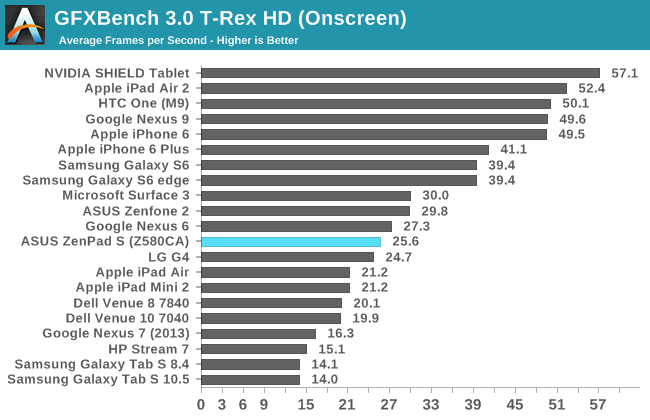
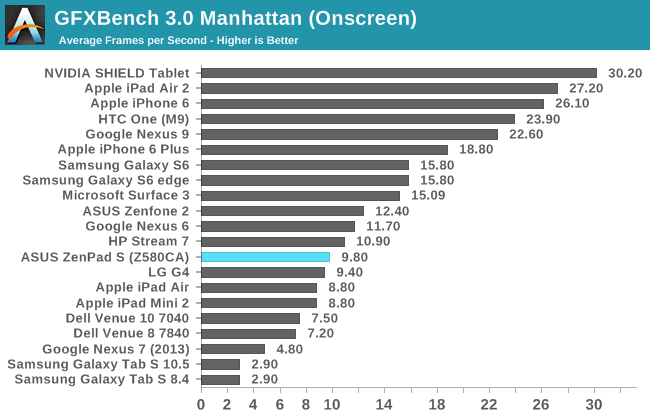
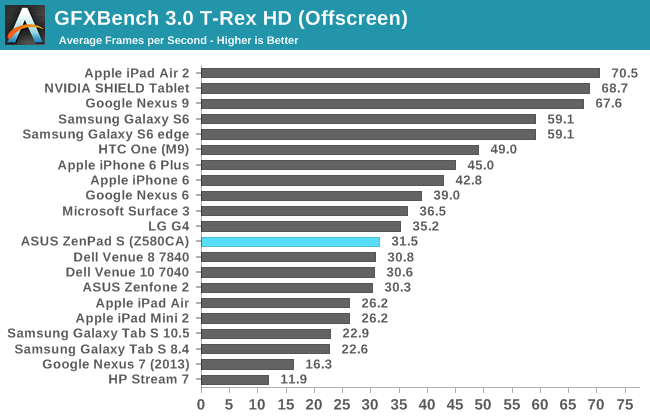

In GFXBench we again see the ZenPad S performs worse than the ZenFone 2 at its native resolution, but the overall GPU power of the two devices is equal. Like the Venue 8 and Venue 10, the PowerVR G6430 implementation in Atom Z3580 outperforms Apple’s A7 by a significant degree in the T-Rex HD test, but not in any other.
It’s clear from our tests that the GPU performance of the ZenPad S Z580CA is roughly the same as Apple’s iPad Mini 2. Since both devices have the same price, the ZenPad S is right where it needs to be in this regard. Performance in programs running at a device’s native resolution will obviously be slower than the ZenFone 2 due to the ZenPad S’s higher resolution, but I think G6430 provides more than adequate performance to run the display, and is the best you’ll be able to find in a $299 device right now.
NAND Performance
The performance of a mobile device's internal storage can have a significant impact on performance. When any applications are performing reads or writes in the background, a low NAND solution can cause the tasks the user is currently performing to grind to a halt. On top of that, there are fairly obvious implications for the time it takes to move music, movies, pictures, and other media to and from the device.
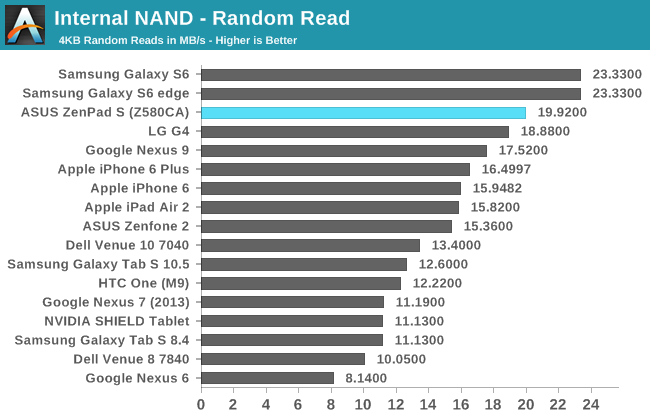
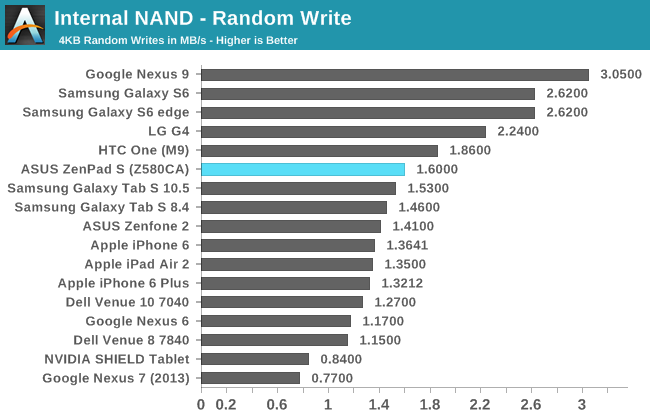
Both random read and random write speeds on the ZenPad S are very good for a mobile device. In both cases it ends up being the fastest tablet on record.
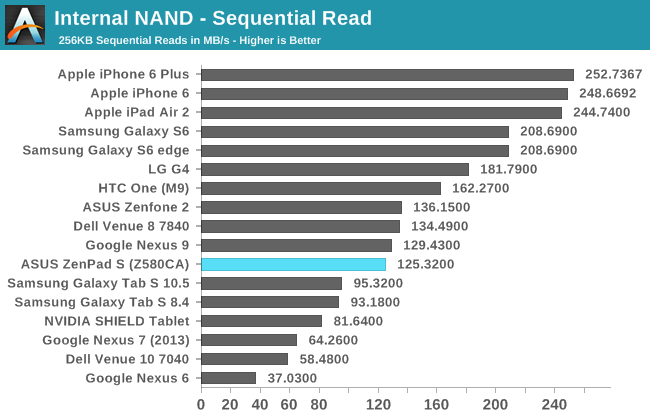
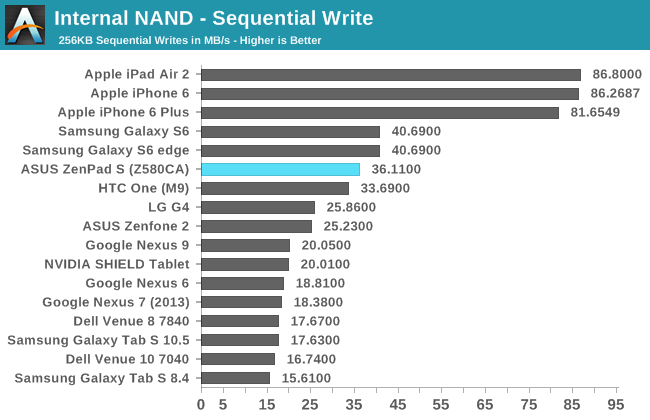
The sequential read speed on the ZenPad S is good for a $299 device, and the sequential write speed is actually the fastest we've seen in an Android tablet. However, it's disappointing to see that Android devices can now adopt USB 3.0 without terrible connectors by using USB Type-C, yet they still have NAND that won't even saturate a USB 2.0 link in the best possible scenario. Relative to the NAND in other Android devices the ZenPad S performs well, but the speed of eMMC flash memory still leaves much to be desired.










114 Comments
View All Comments
uhuznaa - Monday, August 31, 2015 - link
Things are strange right now: You can get an 8" (retina) iPad Mini 2 for $299 and at the same time Android tablets are either a little bit cheaper and really crappy or more expensive and not really much better.If even Apple is struggling now to sell iPads I somewhat doubt that such Android tablets are selling great now...
retrospooty - Monday, August 31, 2015 - link
I dont know about that. I got the $199 Asus Zenpad S 8 a month ago and am loving it. Like all Androids from OEM's, you really need to spend a bit of time to root it and debloat it to make it shine. Debloated this thing flies. For $199 you get an 8 inch 2048x1536 screen, 32gb storage + SD, great build quality, thin, light, great battery life, fingerprint resistant on all surfaces and the CPU is great as well. I was worried about using an Atom chip, but in actual use, it runs perfectly smooth and cool as well. In fact cooler than any Snapdragon device I have ever used. It doesnt get hot at all, ever and I live in Arizona and it's summer. EASILY the best "bang for your buck" available in a tablet right now from any vendor.MrSavage - Monday, August 31, 2015 - link
@retrospooty, I agree with you. People who review a product at a certain price point who want to compare that to products that are about 1/3 more expensive? Or they simply omit the good features like the 64GB onboard storage in this situation, or the front facing speakers, the stylus support or the microSD slot? As if the $299, 2-year old iPad mini 2 with 16GB storage is a wiser choice. If the reviewer wants big battery life, best this, and best that? Then add another $100 to the price of the Tab S2 8.0 for all the features it's lacking that the Z580CA has.BurntMyBacon - Wednesday, September 2, 2015 - link
I agree and disagree. You are welcome to compare it to a product that is 1/3 more expensive, so long as you make it known that that product is 1/3 more expensive. If you stress the comparison against a disparate competitor, then you need to stress the price differential as well. I agree it is disingenuous to point out things that may bring value on one side (display quality, build, aspect ratio, etc.) while ignoring the value adds on the other (SD slot, Storage, Stylus, etc,).Note: My comparison is between two imaginary products and has no bearing on products explicitly or implicitly called out in this article or thread. Comparison was made only to illustrate the point that talking about value distinctions without all of the data is impossible. You may not value the items you left out, but the party you are talking to might.
BurntMyBacon - Wednesday, September 2, 2015 - link
@retrospooty: Given what I've read about the new Atoms, I would probably consider it a boon to a tablet rather than a point of worry. A lot of people seem to be on an ARM or nothing kick. While I was pretty enthusiastic about ARM processors (still am) and I love the competition and what it has done for Intel's low end, I now find there is a lot to like about the Atoms in this form factor as well. Atom got a bad name from its netbook days when it was, frankly atrocious for the application. Now it has matured significantly from a performance / watt standpoint and is running an OS that doesn't run like dirt on low end processors. Of course another nicety of the Atom is its ability to support alternate x86 operating systems if you really want to, but then you have to question whether it is capable of giving you the experience you want. ARM will probably move ahead with its A72 in the near future, but that's a good thing. A little back and forth is good for keeping things moving.BugblatterIII - Monday, August 31, 2015 - link
Do not trust Asus to fix issues!I had (and still have) a Transformer Prime. They never managed to get that working acceptably.
Base your buying decision on how it is at launch, and if they do manage to fix the issues then count that as a bonus.
MrSavage - Monday, August 31, 2015 - link
Did you not get the dongle they created? The Prime was a design flaw. They couldn't software fix their way out of it. If you didn't or don't have the dongle, then I suppose blame yourself.invinciblegod - Monday, August 31, 2015 - link
oh REALLY, an external GPS dongle to do what it should have done in the first place? No, no one should blame themselves, they should blame asus for making a bad product.MrSavage - Monday, August 31, 2015 - link
A design flaw is a design flaw. You can hold onto that issue for the rest of your life if you so choose. You want to miss out of price friendly Asus products because of a design flaw on a second even generation, ground breaking device, then be my guest. I bet you didn't even know about the dongle. The fact is the issue was resolved, albeit a lousy solution. Again, you hold that against them for the rest of your life. That's your odd choice, and if you're okay with it, then so am I.3DoubleD - Monday, August 31, 2015 - link
The dongle fiasco was far from the worst of it though - missing GPS on a 10" tablet was really not a big deal. The Transformer Prime was a complete failure in the end due to the TERRIBLE eMMC that was used. Storage performance just plummeted after a time and while the occasional TRIM helped a bit, it was (and still is) painful to use. Once you are in an app... not so bad. Navigating Android was like watching grass grow... very choppy, laggy grass.It was very sad what happened to the Prime... I remember when I first got it, it blew away any Android device I'd ever used. It is one of two electronic device or computer component purchases I've completely regretted buying. (The other was an AGP Radeon x850XT... that was just outright stupidity on my part)
So that experience colors my view of all ASUS products now. They make some nice looking devices that sometimes have great value... but I just can't help think that they are not fully tested. (As for their PC components, I've had nothing but good experiences)